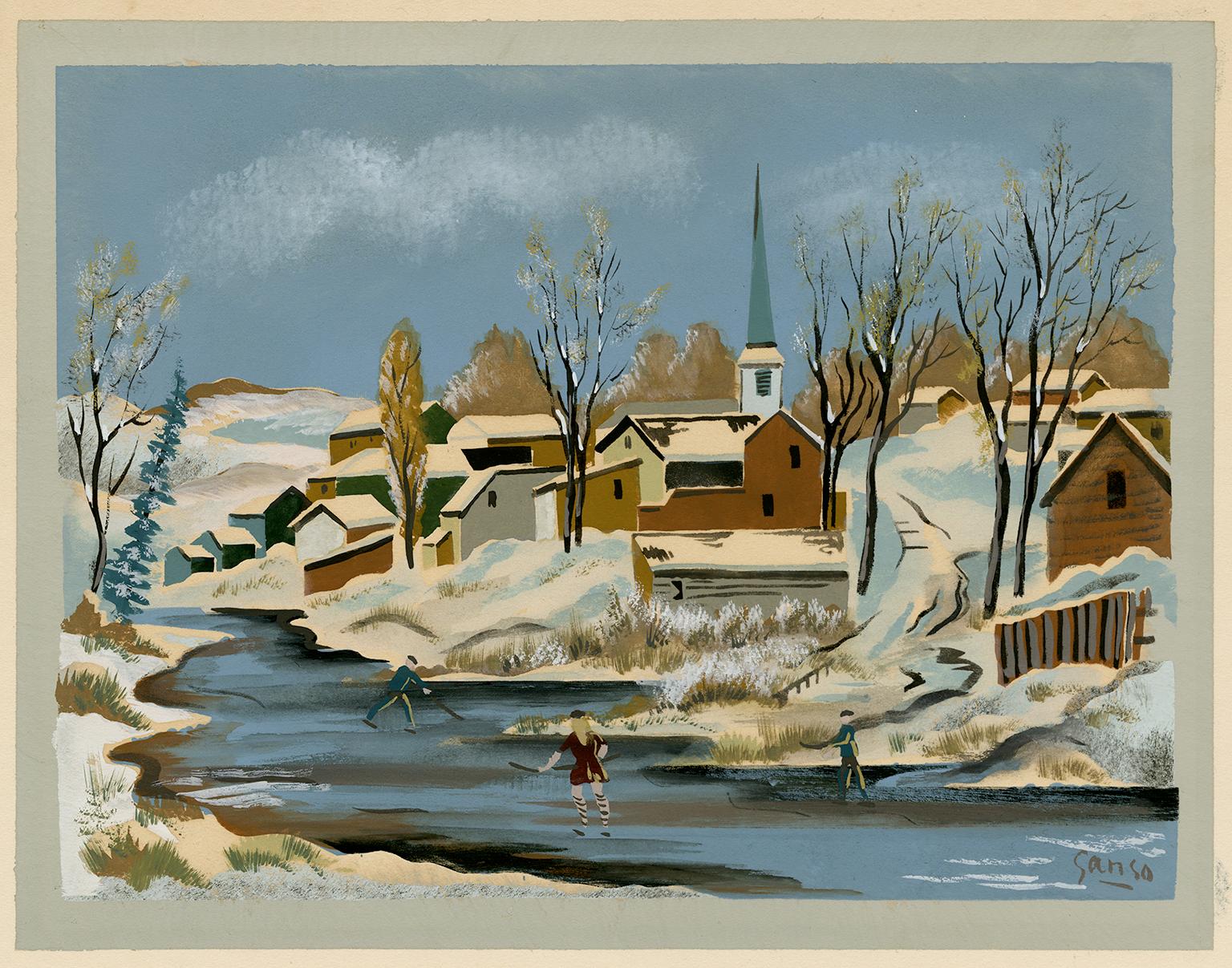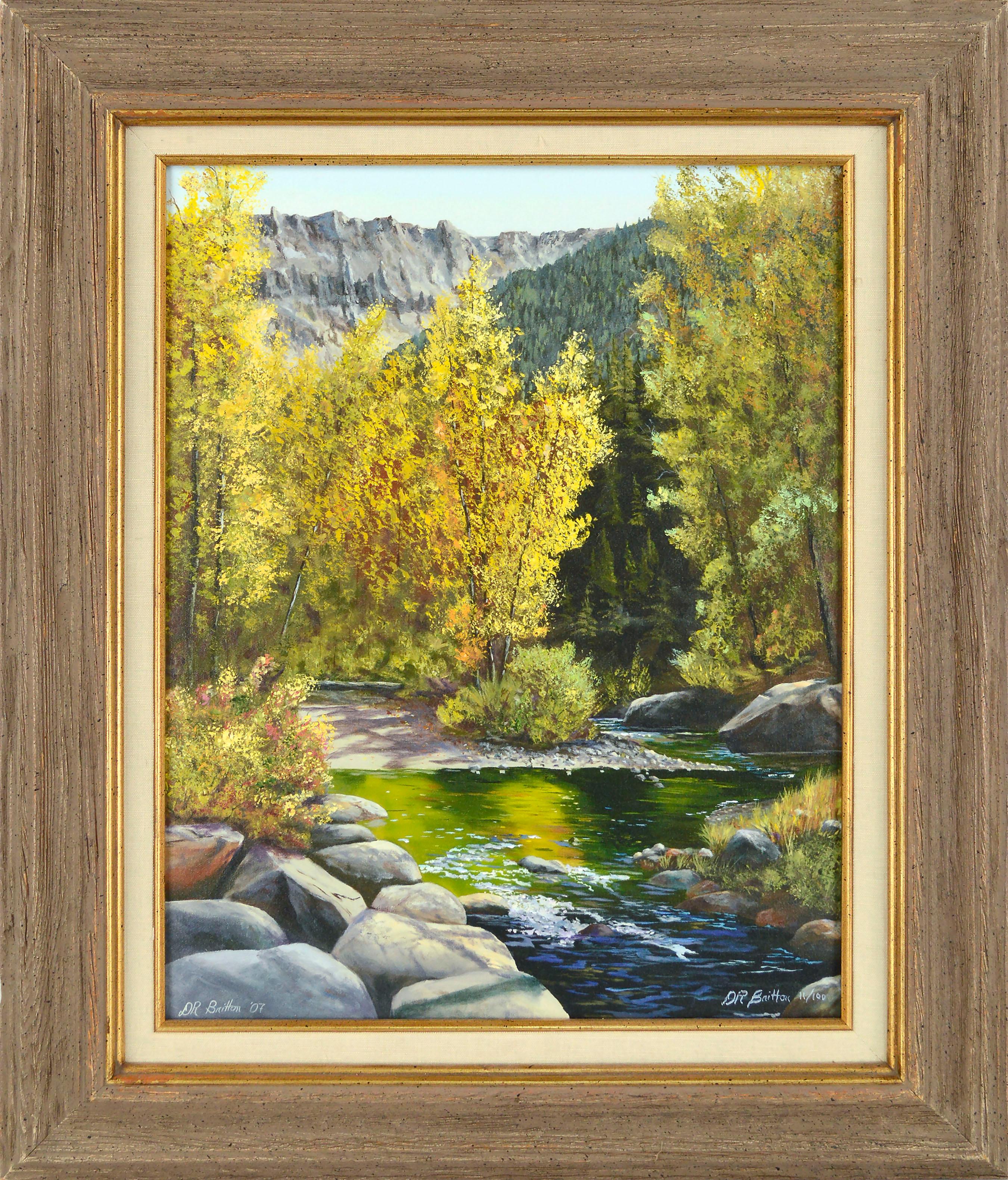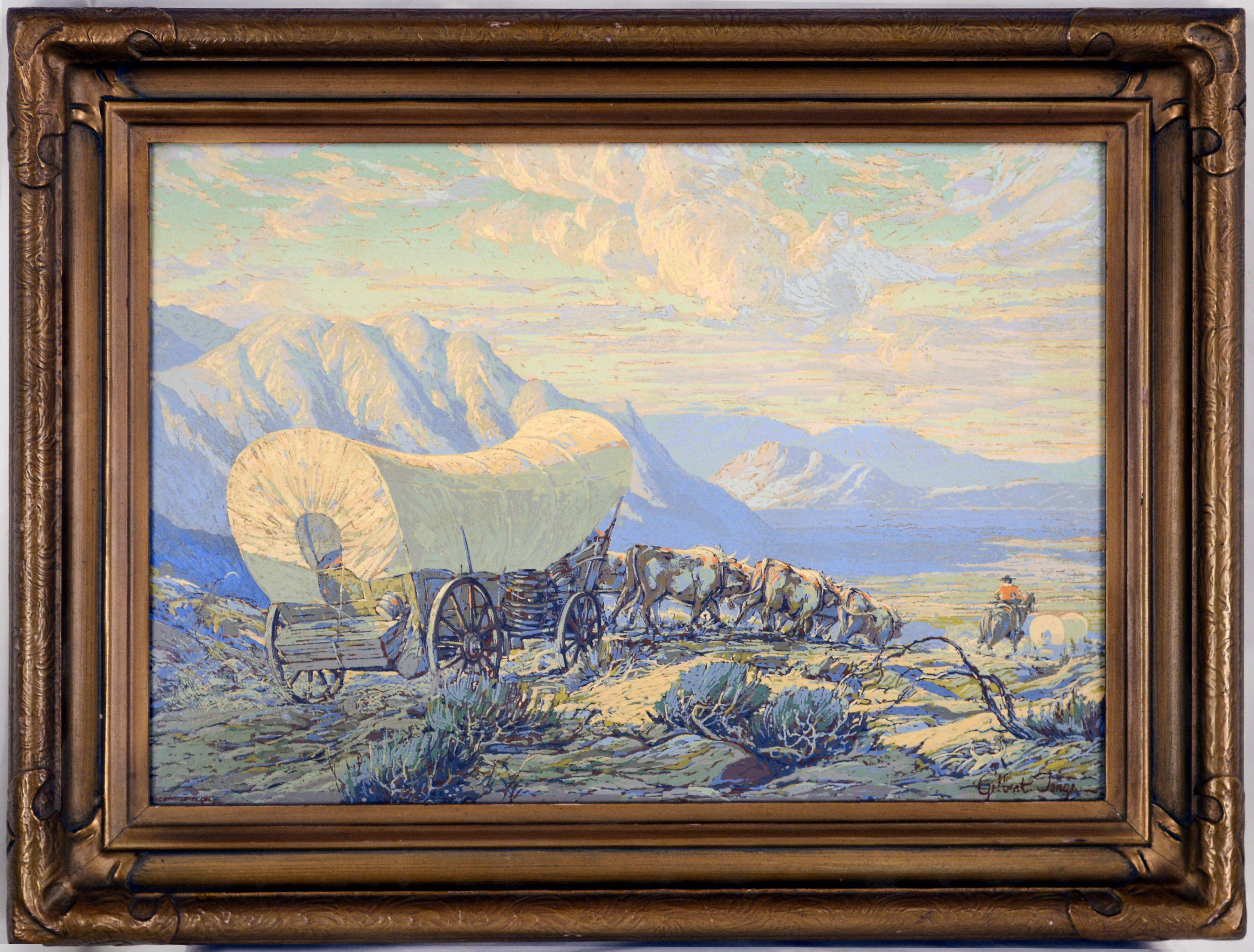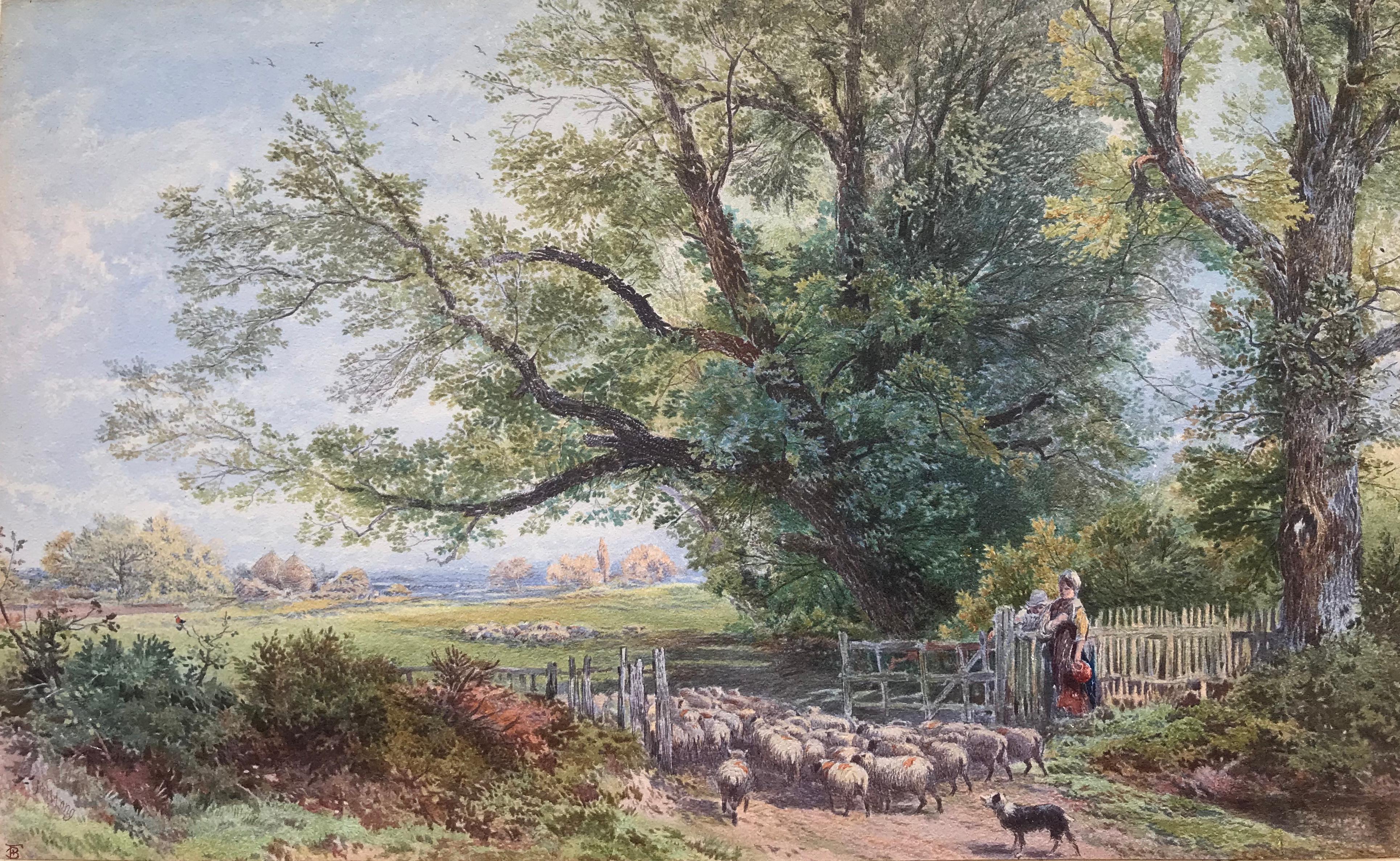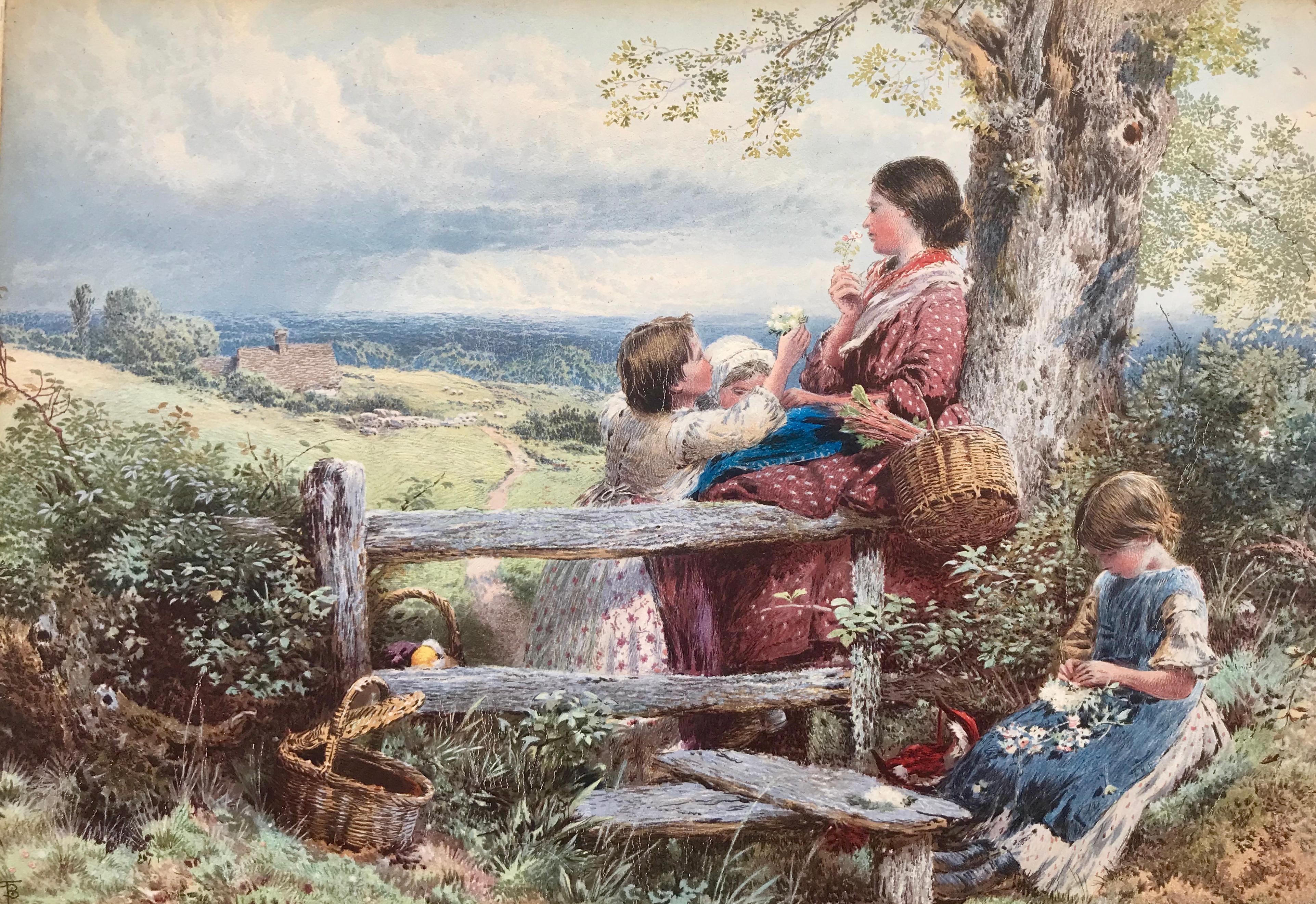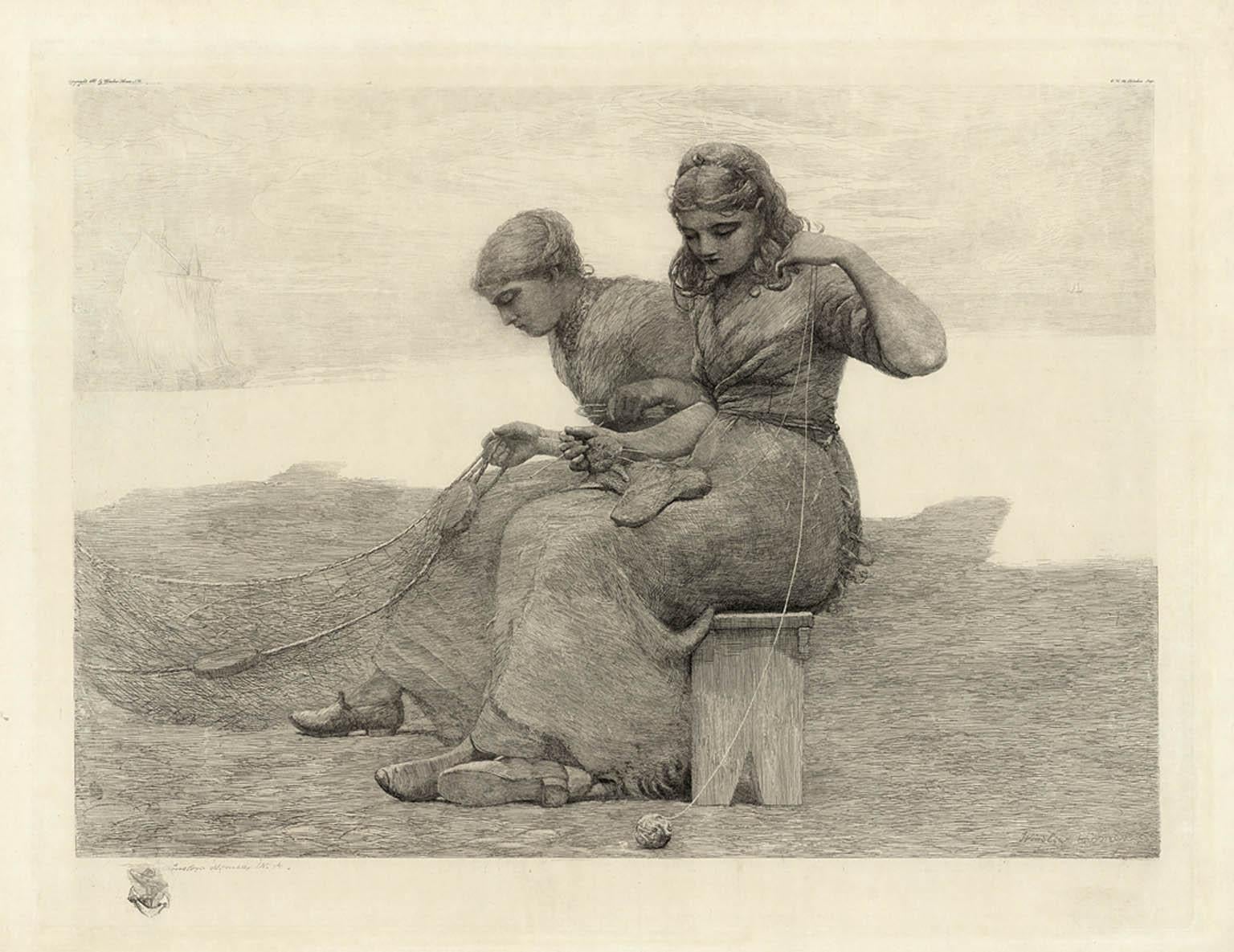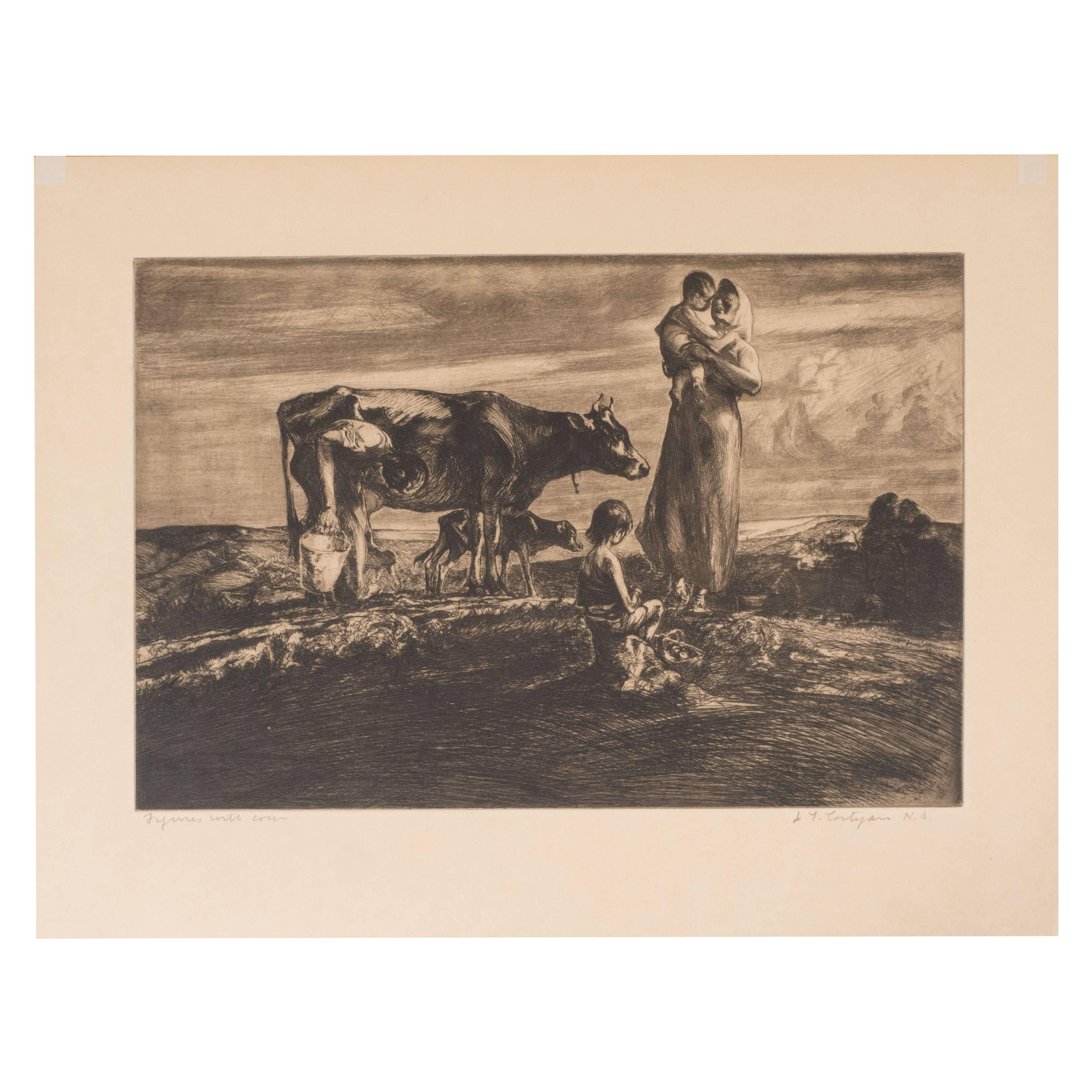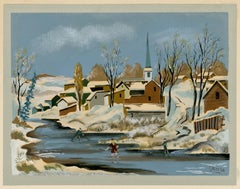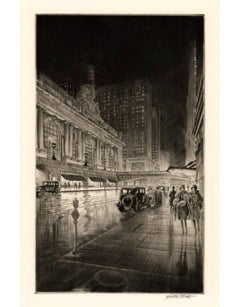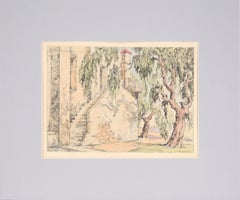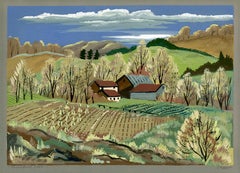
Autumn — Woodstock, NY
Emil GansoAutumn — Woodstock, NYc. 1930s
c. 1930s
About the Item
- Creator:Emil Ganso (1895 - 1941, German)
- Creation Year:c. 1930s
- Dimensions:Height: 10.75 in (27.31 cm)Width: 14.88 in (37.8 cm)
- Medium:
- Movement & Style:
- Period:
- Condition:
- Gallery Location:Myrtle Beach, SC
- Reference Number:Seller: 1032291stDibs: LU53236652522
Emil Ganso
Emil Ganso was born in Halberstadt, Germany, in 1895 and came to the United States as a teenager. By 1914, Ganso was taking evening classes at the National Academy's School of Fine Arts while supporting himself as a baker. His work was soon identified by Erhard Weyhe who went on to show Ganso's work at the Weyhe Gallery. Ganso first exhibited at the Society of Independent Artists in 1921, as well as at the Salons of America from 1922–25. By 1925, Weyhe Gallery began to represent Ganso, which gave him the funds to spend his first summer in the art colony of Woodstock, New York in 1926. Weyhe Gallery continued to exhibit Ganso's work through the 1940s. In Woodstock, Ganso met George Ault, Doris Lee, Charles Rosen, Katherine Schmidt, Eugene Speicher, Alexander Brook, Louis Bouché, Konrad Cramer, Leon Kroll and George Bellows leading Ganso to settle in Woodstock and continue to benefit from Woodstock connections throughout his life. In 1927, the same year he settled in Woodstock, Ganso began to share a studio with Jules Pascin. Ganso printed Pascin's lithographs and prepared a paper for him in 1927–28 while Pascin was in America. In 1929, Ganso visited Pascin in Paris. Perhaps it was this Paris trip that sparked Ganso's interest in photography. By 1930, he was exploring photography as an art form, as well as an aid to his art compositions. Konrad Cramer, Yasuo Kuniyoshi, and Russell Lee were other Woodstock artists who joined Ganso in these photography pursuits. Ganso received a Guggenheim Fellowship in 1933, which he used to study and paint in Europe. In the 1930s, Ganso also kept a studio at 54 West 74th Street, an artists' building, where Walter Pach and Theresa Bernstein also had studios. Leonard Bocour who founded Bocour Artists Colors, which in the late 1940s developed Magna paints and the first acrylics credits Ganso, inspiring him to create artist paints and introduced him to the major artists of the 1930s, including Yasuo Kuniyoshi and Reginald Marsh. Ganso was the first artist Bocour visited while still in high school in 1930 and Ganso taught Bocour how to mix paints and grind his pigments. According to an oral history Bocour gave to the Archives of American Art, Ganso was the master theoretician and leading technical person in Woodstock who all the major artists came to for help with their color due to Ganso's library of German art books including Alexander Dorner's The Way Beyond "Art": The Work of Herbert Bayer which was not translated into English until 1947. In 1930, Ganso began to be invited to exhibit at the Corcoran Gallery of Art, Washington, DC (1930–35); the Art Institute of Chicago; the Wichita Art Museum, Kansas; the Pennsylvania Academy of the Fine Arts (1931–38); and the Whitney Museum of American Art (1927–41). Ganso also exhibited at both the 1939 New York World's Fair and the Golden Gate Exposition in San Francisco that same year. Ganso was awarded the “Pennell Memorial Medal” from the Pennsylvania Academy of the Fine Arts in 1938. As a result of the success of his art, Ganso was offered an artist-in-residence position in 1940 at the University of Iowa. It was there that he died in 1941. A retrospective exhibition for Emil Ganso was held at the University of Iowa Museum of Art both upon his death and in December 1979.
- 'Skaters' — 1930s Woodstock, New YorkBy Emil GansoLocated in Myrtle Beach, SCEmil Ganso, 'Skaters', pochoir (color stencil) with hand painting, edition c. 50, 1938, Smith S-6. Signed in the image, lower right. A rich, painterly impression, with fresh colors, on buff wove paper; the full sheet with margins (7/8 to 1 7/8 inches), in excellent condition. Matted to museum standards, unframed. Image size 11 3/4 x 15 1/4 inches; sheet size 18 3/4 x 13 3/4 inches. An impression of this work is in the permanent collection of the Philadelphia Museum of Art. ABOUT THE ARTIST Born in Germany, Emil Ganso (1895-1941) came to the United States with his family in 1912. After settling in New York City, he found night work in a bakery and concentrated on his art in the daytime—mostly self-taught at this time, he studied only briefly at the National Academy of Design. In 1924, Ganso showed his drawings to Carl Zigrosser, who organized the artist’s first solo exhibition, at the Weyhe Gallery. Soon afterward, Ganso enrolled in Eugene Fitsch’s printmaking class at the Art Students League. Although he considered himself primarily a painter, Ganso made prints in all media, including relief and stencil prints and complex intaglios, and even experimented with color lithography in the late 1920s. He also developed, with an engineer, the design and fabrication of an innovative etching press. In 1926, Ganso attended the Art Students League summer session in Woodstock, New York. There, he met Jules Pascin, and the two artists began a close friendship, briefly sharing a studio. Ganso followed Pascin to Europe in 1928. In 1929, Ganso returned to New York and showed his work regularly in group exhibitions. He continued working in Woodstock in the summer months, often printing lithographs for other artists. The Cleveland Print Club...Category
1930s American Impressionist Landscape Prints
MaterialsGouache, Stencil
- The Plaza, Sunset GlowBy Walter TittleLocated in Myrtle Beach, SC'The Plaza, Sunset Glow', drypoint, c. 1920s, edition not stated. Signed in pencil and initialed in the plate, lower right. Titled 'The Plaza, Sunset' and annotated 'no. 165' in ink, in the bottom left sheet corner. A superb, luminous impression in dark brown ink, with selectively wiped plate tone; on cream wove paper; the full sheet with margins (1 to 2 1/4 inches). Pale tape stains on the top sheet edge, recto, well away from the image, otherwise in excellent condition. Matted to museum standards, unframed. A view across 'The Pond' in New York City's Central Park, toward Grand Army Plaza...Category
1920s American Impressionist Landscape Prints
MaterialsDrypoint
- Grand Central, NightBy Walter TittleLocated in Myrtle Beach, SCWalter Tittle, 'Grand Central Night', drypoint, edition not stated, c. 1920s. Signed in pencil. Titled, and annotated '36.00' and with the inventory numb...Category
1920s American Impressionist Landscape Prints
MaterialsDrypoint
- 'Ship Rock, New Mexico' —By Albert GrollLocated in Myrtle Beach, SCAlbert Lorey Groll, 'Ship Rock, New Mexico', etching, c. 1910. Signed and titled in pencil. A fine, richly-inked impression on cream, wove paper, the full sheet with margins (1 to 1 3/8 inches); a slight paper defect in the center-left margin, away from the image, otherwise in excellent condition. Image size 7 7/8 x 10 inches (200 x 254 mm); sheet size 10 1/8 x 12 15/16 inches (257 x 329 mm). Scarce. Provenance: Ex. collection Kennedy Galleries, in their original gallery mat with label attached. ABOUT THE ARTIST Albert Lorey Groll (1866-1910) was born in New York in 1866, the son of a pharmacist immigrant from Darmstadt, Germany. During his early years, he traveled to Europe to study at the Royal Academy of Fine Arts in Munich under Nicholas Gysis and Ludwig von Löfftz. He further pursued his studies in London and at the Royal Academy of Fine Arts in Antwerp, Belgium. Groll returned to New York in 1895 and moved from figure to landscape painting while expanding his interests to printmaking. In 1904 Groll made the first of several trips to the American Southwest, traveling to Arizona with ethnographer Stewart Culin of the Brooklyn Museum. Later he went to New Mexico with his friend, the artist and illustrator William Robinson Leigh (see our 1stDibs listing no. LU53239015112 ). He focused on impressionistic scenes of Native American lands. The Laguna Pueblo people admired Groll's paintings, honoring him with the name "Chief Bald Head Eagle Eye." Groll kept a studio in the Gainsborough Studios in Manhattan and won several awards for his work in Arizona and New York, including the Salmagundi Club Shaw Prize in 1904 and a gold medal at the Pennsylvania Academy of Fine Arts in 1906. He was also awarded the George Inness gold medal from the National Academy of Design in 1912 for his painting of Lake Louise in the Canadian Rockies. In 1910 he was elected into the National Academy of Design and, in 1919, an associate member of the Taos Society...Category
1910s American Impressionist Landscape Prints
MaterialsEtching
- ShippingBy Kerr EbyLocated in Myrtle Beach, SCKerr Eby 'Shipping' also 'Shipping, Connecticut', etching and sandpaper ground, 1932, edition 100, Giardina 171. Signed in pencil and titled 'Shipping' in the bottom left sheet edge. A superb, atmospheric impression, with skillfully controlled plate tone, on heavy, cream wove paper; the full sheet with wide margins (2 to 2 3/4 inches), in excellent condition. Matted to museum standards, unframed. Image size 8 3/8 x 17 1/4 inches (316 x 176 mm); sheet size 13 7/16 x 8 3/8 inches (341 x 213 mm). The scene depicted was on the Connecticut coast...Category
1940s American Impressionist Landscape Prints
MaterialsEtching
- St. Paul's Church (St. Paul's Chapel, New York City)By Bror Julius Olsson NordfeldtLocated in Myrtle Beach, SCB.J.O. Nordfeldt, 'St. Paul's Church' (St. Pauls' Chapel), etching, edition not stated, c. 1915. Signed in pencil. A superb, richly-inked impression, with skillfully controlled plate tone, printed on off-white, antique, laid paper; the full sheet with margins (5/8 to 2 1/4 inches), in very good condition. Scarce. Matted to museum standards, unframed. An impression of this work is in the permanent collection of the Smithsonian American Art Museum. ABOUT THE ARTIST A solo exhibition of Nordfeldt’s etchings and woodcuts was presented by the Smithsonian Institution in 1926. In 1920, Nordfeldt had a one-man show at the Chicago Arts Club. In 1926, he won the bronze medal at the sesquicentennial exposition in Philadelphia and the Logan Medal at the Art Institute of Chicago. In 1927, he won the first annual prize from the Brooklyn Society of Etchers, and the following year he won first prize from the Chicago Society of Etchers. In 1929, Nordfeldt had a one-man show at the Denver Art Museum. Nordfeldt's work is held in numerous museum collections including Amon Carter Museum of Western Art, Ft. Worth; Anschutz Collection, Denver; Art Institute of Chicago; Biblioteque d’Art et d’Archeologie, Paris; British Museum, London; Corcoran Gallery of Art, Washington, DC; Los Angeles County Museum; Metropolitan Museum of Art, New York City; Museum of Fine Arts, Santa Fe; National Museum of American Art, Smithsonian Institution, Washington, DC; National Gallery, Sydney, Australia; Phillips Collection, Washington, DC. ABOUT ST. PAUL'S CHAPEL St. Paul's Chapel, nicknamed "The Little Chapel That Stood", is an Episcopal chapel located at 209 Broadway, between Fulton Street and Vesey Street, in Lower Manhattan, New York City. Built in 1766, it is the oldest surviving church building in Manhattan, and one of the nation's finest examples of Late Georgian church architecture. It is a New York City Landmark and a National Historic Landmark. The Hearts of Oak, a militia unit organized early in the American Revolutionary War, and composed in part of King's College (later, Columbia University) students, would drill in the Chapel's yard before classes nearby. Alexander Hamilton was an officer of this unit. The chapel survived the Great New York City Fire of 1776 when a quarter of New York City (then confined to the lower tip of Manhattan), including Trinity Church, burned following the British capture of the city after the Battle of Long Island during the American Revolutionary War. George Washington, along with members of the United States Congress, worshipped at St. Paul's Chapel on his Inauguration Day, April 30, 1789. Washington also attended services at St. Paul's during the two years New York City was the country's capital. Above Washington's pew is an 18th-century oil painting of the Great Seal of the United States, adopted in 1782. The rear of St. Paul's Chapel faces Church Street, opposite the east side of the World Trade Center site. After the attacks on September 11, 2001, which led to the collapse of the twin towers of the World Trade Center, St. Paul's Chapel served as a place of rest and refuge for recovery workers at the WTC site. For eight months, hundreds of volunteers worked 12-hour shifts around the clock, serving meals, making beds, counseling and praying with firefighters, construction workers, police, and others. Massage therapists, chiropractors, podiatrists, and musicians also tended to their needs. The church survived without even a broken window. Church history declares it was spared by a miracle sycamore on the northwest corner of the property that was hit by debris. The tree's root has been preserved in a bronze memorial...Category
1910s American Impressionist Landscape Prints
MaterialsEtching
- Armistice Day, 1918By William MeyerowitzLocated in New York, NYWilliam Meyerowitz (1898-1981), Armistice Day, 1918, etching with watercolor. Edition not stated. Signed in pencil. Signed and dated in the plate, lower left. Image size 9 3/4 ...Category
1910s American Impressionist Landscape Prints
MaterialsWatercolor, Etching
- Corkscrew Willows with Stairs - Hand Colored Drypoint Etching California AdobeLocated in Soquel, CADelicate and detailed etching by Orpha Klinker (American, 1891-1964). At the edge of an old Adobe building, a staircase leads to the second floor. The stucco on the walls of the building is cracked, revealing the stonework below. Next to the building is a garden with Corkscrew Willow trees. One of her first projects with which Orpha impressed the public was a notable series of her large color portraits of California pioneers in the L.A.TIMES under the heading of "Speaking Of Pioneers." This led to another series on landmarks and famous tales of early California including oil paintings of historic adobes, buildings, and trees of California. Signed in plate, lower left. Paper size: 8.5"H x 10.5"W Mat size: 10"H x 12"W Orpha Klinker (American, 1891-1964) graduated from Polytechnic High School, L.A. and later studied at U.C.L.A. Art School and at the Cannon Art School. Artists Paul Lauritz and Anna A. Hills of Laguna Beach were her first art teachers. She continued her study of art at the Julian and Colarossi Academies in Europe. Some of her earliest work was in designing. Many pages of her fine pen work drawings appeared in Los Angeles newspapers, illustrating the fashions of the day, not only in clothes but in furniture and other things. Then for a time she did her work in New York City and later with the Ladies Home Journal in Philadelphia. One of her first projects with which Orpha impressed the public was a notable series of her large color portraits of California pioneers in the L.A.TIMES under the heading of "Speaking Of Pioneers." This led to another series on landmarks and famous tales of early California including oil paintings of historic adobes, buildings, and trees of California. From the Mexican border to Death Valley she roamed, meeting and painting portraits of such characters as Death Valley Scotty, Shoshone Johnny, the ancient Indian who supposedly saw the first white man come to Death Valley, Emanuel A. Speegle, "The Last of the 49'ers" (over 90 years of age) and others. Orpha was active in keeping alive the memory of one historical event in particular, the signing of the Treaty of Cahuenga ending the Mexican War...Category
1930s American Impressionist Landscape Drawings and Watercolors
MaterialsDrypoint, Watercolor, Paper
- Bathers with Sainte Victoire Mountain - Lithograph and Stencil Watercolor, 1947By After Paul CezanneLocated in Paris, FRPaul CEZANNE (after) Bathers with Sainte Victoire Mountain Lithograph and Stencil watercolor (printed in Jacomet workshop) After a watercolor painted c. 1902/07 On heavy paper 12.6 ...Category
1940s Impressionist Landscape Prints
MaterialsLithograph, Stencil, Watercolor
- D. P. Weier Monoprint Oil Landscape "Birch Forest"Located in Detroit, MISALE ONE WEEK ONLY “Birch Forest” is a monotype oil. The process is the simplest form of printmaking in a way because the artist does not etch or carve into a plate. Instead, a mono...Category
20th Century American Impressionist Landscape Prints
MaterialsOil, Paper
$1,680 Sale Price40% Off - Sierra Mountain Stream in Autumn, Contemporary California Giclée on CanvasLocated in Soquel, CASubstantially framed contemporary limited edition giclée print on canvas of a beautiful plein air impressionist landscape painting by California artist Donald R. Britton (American, b.20th Century), 2007. Some small areas of oil paint highlights added to canvas print by the artist. The landscape features a calm mountain stream flowing past large boulders and yellow autumn trees, with tall majestic mountains in the background. Hand signed lower right "DR Britton" with the edition number 11/100. Signed and dated in the print "DR Britton '07", lower left. Displayed in a custom rustic style contemporary wood frame with linen liner and gold trim. Canvas size: 20"H x 16"W. Don Britton is a contemporary representational landscape painter of the western US with focus on the southwest, the Pacific coast and the Sierras. Recent Awards and Publications: 2019: Juror's Purchase Award, "Pacific Bluffs" at Art for Heaven's Sake Annual Art Festival, Redlands, CA 2016: First Place,"Land Put to A Higher Use", The 9th Annual Ralph Love Plein Air Competition in Temecula, CA 2014: "Canyon Clouds" and "Carmel Wetlands" were juried in to the Museum of the Art Institute Regional Show in San Diego 2012: "View from Mather Point" was selected for installation in the US Embassy in Sri Lanka. 2011: "On the Rocks" selected as a finalist in the Artist's Magazine annual national competition. 2010 - "Your Composition Should Evoke an Emotion" feature article in International Artist, pp 52-59, vol 70, 2010 2010 - "Morning Becomes the Valley" and "Lamoille Canyon" selected for installation in the US Embassy in Yemen 2010 - Grant from Nevada Arts Council 2008 - Grant from Nevada Arts Council 2007 - Paint America National Competition Top 50 Miniatures 2007 - First Place, Oil Painting, Carson Valley Art Association Annual Exhibit Artist’s Statement: I have been surrounded by artists virtually all my life. I received my first drawing instruction at the age of six from my father. We were living in New Mexico at the time and he was an avid amateur landscape painter there. Although I dabbled in painting off and on for years, my first career took a different path. Following a BA from the University of Colorado and a PhD from The Ohio State University I entered a career in neuroscience research. However, in 2004, I committed to painting full time and was almost immediately rewarded with the joy of recreating scenes I loved. I am indebted to numerous mentors along the way including Mark Tompkins, Skip Whitcomb, William Scott Jennings, Jim Wilcox...Category
Early 2000s American Impressionist Landscape Prints
MaterialsGiclée, Oil, Canvas
- "The Covered Wagon" On the Oregon Trail Prairie Schooner Horseman and CattleLocated in Soquel, CA"The Covered Wagon" On the Oregon Trail Prairie Schooner and Cattle Facsimile in oil or silk screen Oil print by Gilbert Ross Tonge (American, 1883 - 1970...Category
1940s American Impressionist Landscape Prints
MaterialsOil, Illustration Board, Screen
